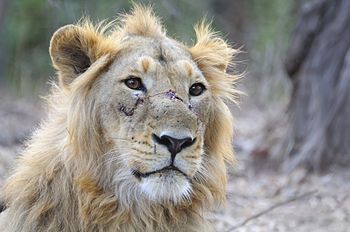Maldhari tribe and their clash with lion conservation
Contents
Maldhari tribe and their clash with lion conservation
| The Maldhari community is a tribe of herdsmen in the border state of Gujarat. The name Maldhari means owner of goods - in this case, goods referring to cattle. The Maldharis have lived in the Gir National Park, in the Banni Grasslands Reserve area, for the past thousand years[1]. They have co-existed with the lions, which the Gir National Park was created to preserve, for these thousand years. The lions have been periodically hunting the Maldhari cattle for food, but the Maldharis understand the cycle of life. They consider the taken cows an offering to the lions, whose territory they share[1].
As is the case across India, the unbridled development over past few years has disturbed the centuries-long lifestyle of these nomadic herdsmen. Although the grassland reserve is off-limits to industries, several exist at its periphery and have been dumping toxic contaminants into the reserve's natural resources. Recently built dams, overgrazing have also taken their toll. Another concern is the tree Prosopis juliflora (Ganda Bawal), which was introduced by the Forest Department for its salinity-resistant characteristic in the 1980's and which grew into an invasive species threatening local grass and tree species[2]. However, the tribe and its lifestyle was most threatened by the creation of the Gir National Park. Creation of a sanctuary for lions necessitated movement of humans out of the region, so as to provide a safe shelter for the large cats. However, the Maldhari community steadfastly protested any relocation. There were a few tribal groups that were moved from the National Park, however, their relocation procedure was mismanaged[3]. The Maldhari tribesmen have had to face eviction threats and accusations by government authorities of endangering the lions, just for living in the land of their forefathers[4]. In addition, due to mismanagement of the existing population of lions in the National Park, the interaction between the lions and the tribals have increased over the past few decades[5]. Experts note that although the populations of lions have been increasing, the land has been shrinking. Not only have some lions started exploring outside the reserve for food, but some tribesmen from Maldhari and other communities have also been charged of poisoning or poaching lions[5][3]. This tussle between local communities and conservation almost always turns out bad in the long run. Consider the case of the the Olive Ridley turtles in Orissa, where the fishermen were opposed to conservation for fear of losing their livelihood. Such communities not only possess the knowledge required for devising conservation practices, but also the tools and the zeal. Thus, it is quite critical to involve the local communities in conservation if any tangible, lasting benefits are to be reaped from the effort. In this direction, the government did make an effort by passing the Recognition of Forest Rights Bill 2006, which recognized the rights of forest-dwellers to stay in the land of their ancestors[4]. However, more efforts are required from academics, social activists and concerned government authorities alike to ensure proper integration of local communities in conservation efforts. |
Also see:
Olive Ridley turtles, the fishermen of Orissa and the OMRCC
Other Media
References
- ^ a b Shepherding in a New Era of Livestock Keepers' Rights in India Accessed: November 6, 2011
- ^ Invasive Ganda Bawal tree entry on Wikipedia
- ^ a b Conserving biodiversity in arid regions: best practices in developing nations Page 241
- ^ a b India's forgotten tribes gain rights over forests Reuters. Published: Jan 2, 2007
- ^ a b Disputing The Lion's Share Outlook. Published: July 24, 1996
Comments
blog comments powered by DisqusMore notes like this
| |||||||||||||||||||||||||||||||||||||||||||||||||||||||||||||||||||||||||||||||||||||
Only 15 articles are shown in this list. A total of 64 articles in the database as of this moment. For the complete list, click on further results on the bottom right corner of the above table.
Semantic tags
- Browse all Semantic Tags associated with this page
- Find more pages and articles created by the community by clicking this link.
| Title | Maldhari tribe and their clash with lion conservation | Article is on this general topic | Locals vs conservation | Author | Gaurav Moghe |
|---|---|---|---|---|---|
| Specific location(s) where study was conducted | Not noted | General region where study was conducted | Not noted | State where study was conducted | Gujarat |
| Institutional affiliation | Not noted | Institution located at | Not noted | Institution based around | Not noted |
| Species Group | Mammals | User ID | User:Gauravm | Page creation date | 2011/11/05 |
Share this page:
